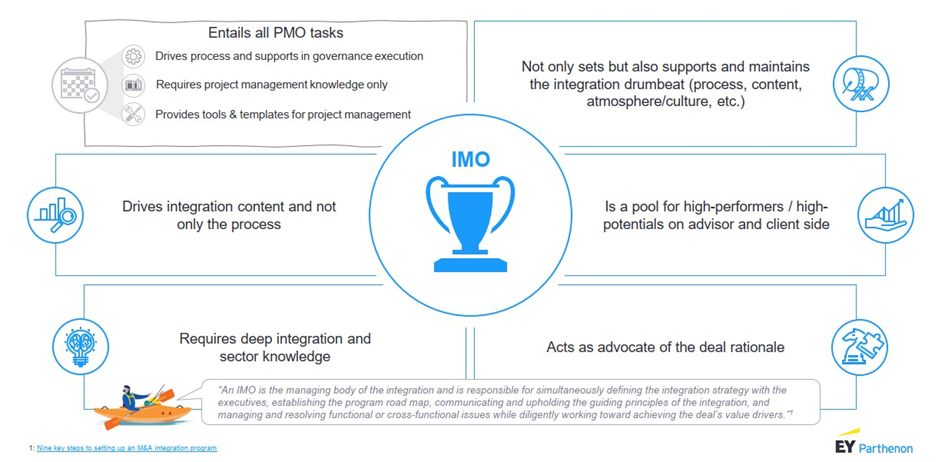EY si riferisce all'organizzazione globale, e può riferirsi a una o più delle società membri di Ernst & Young Global Limited, ciascuna delle quali è un'entità legale separata. Ernst & Young Global Limited, una società britannica a responsabilità limitata, non fornisce servizi ai clienti.

Authors: Tim Blechschmidt and Alena Viebahn
Successfully steering the vessel that is corporate mergers and acquisitions demands the robust structure and strategic insight of an Integration Management Office (IMO). In this piece, we delve deep into the vital role of IMOs, analyzing their key attributes, offering proven strategies and unraveling unique best-practices for orchestrating seamless and highly fruitful corporate integrations.
IMO: The Powerful Engine Propelling Deal Value Realization
An IMO isn't just a team of professionals; it's the epicenter of an integration that manages and synchronizes every move from sign-to-close and beyond. It's the custodian of strategic alignment, stakeholder coordination, and culmination of synergies. It's the linchpin harmonizing the activities from various (legacy) business unit, geographies, and disparate functional areas. Acting as an integration vanguard, the IMO guides, frames, challenges, flags, process-maps and tracks activities to ensure effective and efficient delivery. Moreover, it anticipates and pro-actively manages risks and integration challenges alongside keeping everyone up-to-date and working towards the realization of the deal value drivers.
The IMO is a high performing transformation body that drives all aspects of an integration – it sets and maintains the heartbeat structurally, culturally and from a content perspective

Realizing the sheer complexity of integrations and the high-stakes nature of these projects, alongside the urgency for tangible value creation, an effective IMO serves as the tactical compass in this challenging yet rewarding journey. The eleventh-hour execution of integration lacking a proficient IMO equates to blind navigation through a labyrinth. It invariably culminates in:
- strategic plans disassociated from the deal rationale,
- ill-fitted operating models leading to poor employee experience,
- misaligned integration plans, and a dwindling commitment to the delivery of synergies
Conveying the importance of early-stage set-up, seasoned integrators often advocate for the commencement of IMO planning even before Signing. This highly effective preparatory measurement ensures a thorough understanding of the original deal context, model, and assumptions while clearly elucidating the commitments laid before the board and shareholders.
Anchoring Integration: The Governance Factor
Integration is an expansive expanse that can be overwhelming to traverse without clearly defined governance rules and an agreed-upon framework to guide this journey. May it be buyer representatives that immediately after Close overwhelm the targets organization with meeting and data requests. Or may it be during Sign-to-Close where every function plans for combined operations after Closing in silo’s not looking beyond the end of one’s nose.
The IMO spearheads this front by establishing precisely defined rules and routines to introduce a sense of predictability. The policies provide a blueprint for managing the integration and ensuring on-point consistency. Combined with an organizational structure for the integration which considers the way how the company is used to work as well as the delegation of strategic roles and responsibilities to the team members substantially amplify the accountability factor.
The IMO team members play a crucial role in bringing the integration vision to life through their mindset, work ethics, and communication skills. They should have a repertoire of merger integration experience, profound understanding of the companies’ operations, extensive networking within business units, and a precise knowledge of pre-deal context. Furthermore, their communication prowess should bridge cultural gaps and inspire teams through the integration journey. Critical to this team is the integration leader. This role demands a reputable, experienced professional, ready to ascend to greater heights after successful integration. This figurehead should exhibit bold leadership, act on an explicit mandate, and inspire confidence within the organizations. This leader personifies the guiding star in the integration journey.
Driving your IMO: Unlocking Seamless Integration
- Defining Success, Managing Progress via Stage Gates: Successful IMOs create clear, measurable objectives that align with the strategic goals of an integration. By transforming the Deal Rationale into key performance indicators, they tangibly link the strategic intent with functional planning. To effectively track overall progress, IMOs frequently employ stage gates, linking specific deliverables with crucial milestones. Teams progress only when the deliverables meet defined quality standards, facilitating timely corrective actions, fostering cross-functional alignment and managing deliverable interdependencies. Operating models and synergies serve as such deliverables stress-tested in stage gate events.
- Fostering Collaboration, Clear Communication: Effective IMOs champion a culture of transparent, regular communication to keep all stakeholders informed and aligned on integration plans and progress. They practice proactive collaboration, encouraging the exchange of ideas, feedback, and fostering a cooperative environment. By doing so, they enhance early issue detection and resolution while leveraging collective expertise. The incorporation of face-to-face interactions (e.g. during coffee speed dates, joint workshops and townhalls) and open communication channels, like instant and 24/7 team chats, contributes to a sense of trust, adding more cohesion to the collaborative spirit. As a result, critical buy-in for key decisions is achieved more effectively and promptly.
- Prioritization of Employee Engagement and Celebration of Achievements: Effective IMOs place a high priority on employee engagement and appreciation, acknowledging their contributions to the integration journey. They ensure that employees understand their roles, promoting a sense of value and boosting morale, commitment, and productivity. Celebration of milestones and achievements is a key strategy, fostering excitement and maintaining positive momentum. It also acknowledges the team's effort, bridges cultural gaps, and fosters a shared sense of achievement amid integration complexities. Understanding that integration is a marathon, not a sprint, successful IMOs map out these celebratory milestones early and communicate them in advance.
- Embracing flexibility, learning and adaption: Successful IMOs embrace flexibility and continuous learning as they adapt to the fluid landscape of integration. They regularly reassess governance and integration approaches, open to feedback and adjustments. Regular retrospective meetings create a platform for dialogue on what's working and what needs tweaking. They understand that the path to integration often diverges from the planned trajectory, posing unexpected challenges that demand agility and reassessment. Striking the right balance between beneficial and unbeneficial adaptation is crucial. An iterative, agile project management approach, combined with suitably defined guiding principles, shapes a responsive yet controlled integration journey.
- Proper, Adequate Resourcing: Optimal resourcing is a cornerstone of an effective IMO, requiring a strategic mix of skilled talent, financial investment, and leading-edge technology. Under-resourced IMOs can trigger misplanning, delays, and inefficient executions, resulting in negative team perceptions and risking the intended deal value. Adherence to best practice calls for a diverse, cross-functional team, a steady financial reserve for unexpected costs, and robust digital systems that enhance communication, project tracking, and performance measurement. Additionally, the application of Business Intelligence and AI helps streamline integration and free up resources to concentrate on other vital integration tasks.
Running a successful IMO is akin to conducting a flawless symphony where each player contributes to the harmonious melody that narrates the tale of integration success
Indeed, in M&A's intricate ballet, the Integration Management Office (IMO) is the seasoned conductor. Striking the right chords to create the melodious symphony of clear communication, well-integrated governance structures, well-mapped resources - human, financial, technological - and effectively steering the corporate orchestra in unison. Hence, the success of an IMO is not just about coordinating the integration but creating a magnificent performance that delivers a resonating impact across the corporate spectrum.
Summary
The Integration Management Office (IMO) is the heartbeat orchestrating successful M&A integrations. It unites all aspects of an integration, from strategic planning to synergy delivery, collaboration and communication, to robust resourcing. A successful IMO doesn't only create an integration plan: it conducts a harmonious symphony resulting in flourishing corporate integrations.

